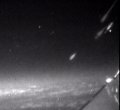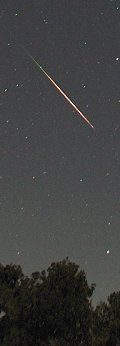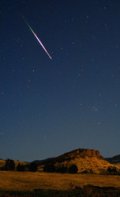| |
| |
Photographer,
Location |
Images |
Comments |
|


|
George Varros,
45,000 feet over the Pacific coast of California
Sep. 1, 2007 |
#1,
#2, movie,
more |
Here is a very rough composite of 4 bright meteors imaged in less than 5 minutes from the Aurigid MAC mission put together by Dr. Peter Jenniskens. Each meteor was brighter than mag 0 although this picture does not show that. The Aurigid MAC mission was an incredible adventure and a wonderful confirmation that the meteor stream model developed by Dr. Jeremy Vaubaullion and Dr. Jenniskens is very accurate; certainly a major accomplishment. I asked Jeremy before the event if he was confident in his predictions which he absolutely was. Awesome! Congratulations!
The second picture is of most of the scientists as we were preparing for a group shot.
My ability to partake in this mission is credited to the American Meteor Society.
|
|

|
John Laird,
Onyx Summit ( just off Hwy. 38) above Big Bear, California, USA
Sep. 1, 2007 |
#1 |
My friend Paul
and I observed the Aurigid Shower last night. I caught this
meteor going just below the constellation Orion. We observed
for a couple of hours. During the best hour from about 4
to 5 a.m. we saw about 35 meteors with a couple of outbursts
of 4 to 5 meteors per minute. It was short, but awesome.
Photo
details: Canon
10D, with a 17
- 35mm lens. Exposure was 20 Sec. @ f2.8. Image was
taken around 4:15 a.m.
--John
Laird, 8th Grade Science Teacher, Fedde Middle School, Hawaiian
Gardens, CA
|
|

|
Charlie
Coupar,
in light-polluted Galt, California
Sep. 1, 2007 |
#1 |
I
watched the shower from 0330 to 0440 PDT and saw about 10
streaks, 8 very bright. photo is in Orion about 30 degrees
above the horizon.
Photo
details: Nikon FM2 ISO 800 Fuji film, 50 mm 1.8
lens wide open at infinity. Time exposure about 5 minutes.
Sept 1, 2007 approx 0430 hrs. |
|

|
Charles
Sterling,
Las Cruces, New Mexico, USA
Sep. 1, 2007 |
#1 |
I
shot a series of 30-second exposures with a Canon
XTi at 18mm,
f/5.6 from about 05:15 MST until 06:00 MST. Only two meteors
were captured, the best at 05:56 MST, nearly dawn. We saw
several others, two or three quite bright. It was a show
worth getting out of bed. |
|

|
Vincent
Varnas,
Ashland, Oregon
Sep. 1, 2007 |
#1,
#2 |
Photo
details: Nikon
D200 with Nikkor AE 35mm, f/2D lens. Exposure was ISO
640, f/2.8 at 15 sec. , white balance was set for daylight.
The Moon was so bright, that it illuminated the butte quite
well.
|
REPORTS:
from
Mike Harms of Clayton, California: "From my home
in Clayton CA I saw a dozen meteors between 4:00am and 5:00am
PDT. Most of them were around 1st magnitude. At about 4:50 am
I observed a "point" meteor. This head on meteor appeared
just below Capella, located about +45degrees dec., 5hr30minutes
RA. It looked like about a first magnitude star that suddenly
came into existance and then was gone in a second."
from
Daniel Fischer of San Juan Bautista, California: "Here's
the raw deal from Fremont Peak, California, before going to bed
(it's 7:15 a.m. now : Three observers saw 30 to 38 Aurigids each
tonight in about 1 1/2 hours under perfect conditions. There was
one striking cluster of three within one second and close to each
other, otherwise there were often long lulls. But the Aur were
nearly all bright and had nice wakes (though no persistent trains).
There was no pronounced maxiumum at either 11:36 or 11:33 (as
the latest models said) UTC, rather here are my counts for 5-minute
intervals from 11:10 to 12:20 UTC (several more Aur were seen
between 10:38 and 11:10 UTC, but not counted systematically):
2 - 5 - 2
- 2 - 2 - 3 - 0 - 0 - 2 - 2 - 0 - 1 - 0 - 0 (then dawn came).
So for us
the peak came early, at 11:15 UTC perhaps. And another strange
observation: In the first half of the outburst, most meteors were
high in the sky - and in the 2nd most every meteor was very low
in the sky. Certainly just a statistical fluke, right ...?"
|
|